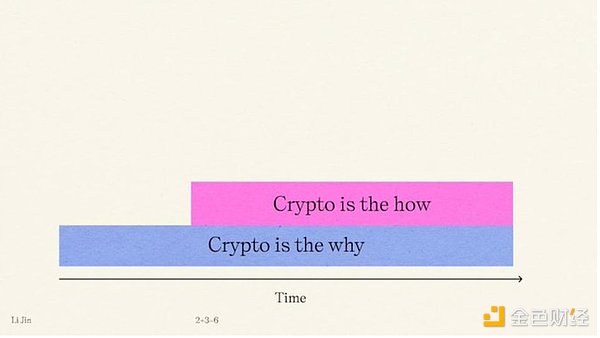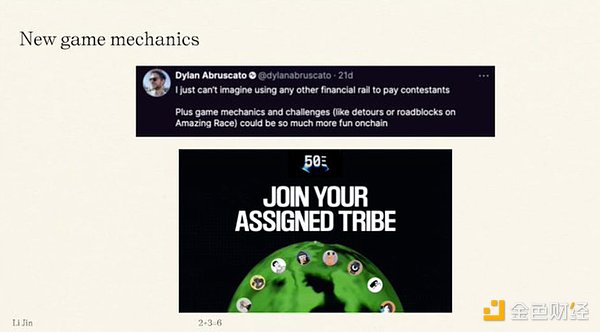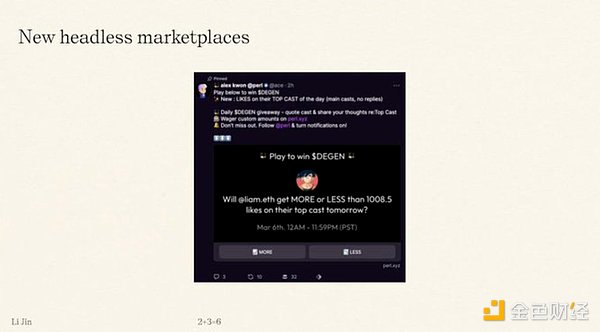Author: LiJin, partner of Vatiant Fund; Compiler: 0xxz@金财经
This article is my work Austin attends part of a Boys Club World presentation.
I observe that the future of consumer cryptocurrencies generally has two paths.

p>
Cryptocurrency began in 2009 with just one asset, Bitcoin, designed to be a non-sovereign currency. Bitcoin is a category of crypto products where crypto itself is the “Why”, meaning the crypto asset is the entire reason people want to use it.

p>
Cryptocurrency is very visible in these products: it’s the whole reason people use it. This category of crypto-as-a-cause products also includes memecoins, PFP, and other products that place cryptocurrencies at the center of their value proposition.
The target users of such products are usually early cryptocurrency adopters, degens etc.
But cryptocurrency is more than just money and assets, cryptocurrency is also a technology. So over the past few years, we’ve started to see builders view cryptocurrencies as a “how.”

p>
In these products, cryptocurrencies are simply technological tools that help accomplish something. Cryptocurrencies are invisible and users have no idea the blockchain even exists. This part of the product is aimed at ordinary mainstream users who have pain points and just hope that a product can better solve this problem.
Both categories of products are growing and I think both will be hugely successful.
But beyond that, what we are seeing now is a new wave of innovation that I call "use-only" Cryptocurrency”: Products that use the building blocks provided by cryptocurrencies to create new experiences.

p>
In this category, encryption unlocks a whole new design space and creates engaging experiences that were simply not possible in web2 before.
The portion of the product that can be built "only with cryptocurrencies" has features rooted in the capabilities that cryptocurrencies uniquely bring:
Global payment channels, composability of on-chain assets and identities, creation of new markets and new assets.
These elements combine to unlock new experiences.

p>
Let’s look at some examples!
Last month I participated in cryptothegame, a survivor-style online game show, for two weeks. There are certain dimensions of the game that are only possible through encryption.
First and foremost, it is built using cryptographic payment channels, allowing it to involve real monetary rewards and be available globally from day one. Its founder, Dylon Abruscato, said he couldn't imagine developing the game on any other financial system. In the future, you could imagine games introducing all kinds of novel mechanics that leverage cryptography, such as embedded prediction markets that allow viewers to bet on what happens next, adding another layer of engagement in web2.

p>
Another example of “cryptocurrency only” are new networks that would not be possible without cryptocurrencies.
Based on my market investment experience over the past seven years or so, I realize that there should be some markets and network types in the world, which means they Will benefit end users, but in fact these markets and networks do not exist because of huge market and network cold start problems.
Examples include everything from new dating apps to hyperlocal social networks to marketplaces for a variety of services—which many web2 founders are trying to Networks that have been established but are experiencing significant difficulties in getting started or scaling.
You can build these networks using tokens as new bootstrap tools. What excites me about this category is that instead of using tokens to recreate a network that already exists in web2, you're building an entirely new network that doesn't currently exist.

p>
Another example of something only possible with crypto is new composable applications and distribution channels that connect to users’ wallets to enable richer operations.
Frames launched by Farcaster last month is a framework for mini-applications that can be distributed within Farcaster. Farcaster is a decentralized Social network. In other words, these apps serve users' needs where they already spend their time and where their wallets are already connected. We've already seen developers use this new framework to create experiences ranging from ordering Girl Scout cookies to minting NFTs from social media feeds.

p>
As an extension, composability allows you to create headless markets that leverage global on-chain liquidity, but the end user experience allows users to connect wallets anywhere needs. The end result is reduced transaction friction and deepened liquidity network effects. For example, we've seen prediction markets built as Farcaster Frames - where users can bet on certain outcomes from their social feeds. (See my partner Jesse Walden's article on headless markets "Wallets, Composability, and Headless Markets" https://jinse.cn/blockchain/3674117.html.)
These are some examples of products that can be built "using only cryptocurrencies", with new examples added every day.

p>
This is the category of apps and web that I'm most excited about and I believe will bring the next wave of users.
Just like technology companies in web1 and web2 before they could only run on these new computing platforms, applications in web3 The advantages offered by encryption technology will be leveraged to deliver a differentiated experience that cannot be found elsewhere.
As a long-term consumer investor, I am very excited about this future!

p>
 JinseFinance
JinseFinance
 JinseFinance
JinseFinance JinseFinance
JinseFinance Alex
Alex Edmund
Edmund Edmund
Edmund Hui Xin
Hui Xin JinseFinance
JinseFinance JinseFinance
JinseFinance Ftftx
Ftftx Ftftx
Ftftx